Correction Mode
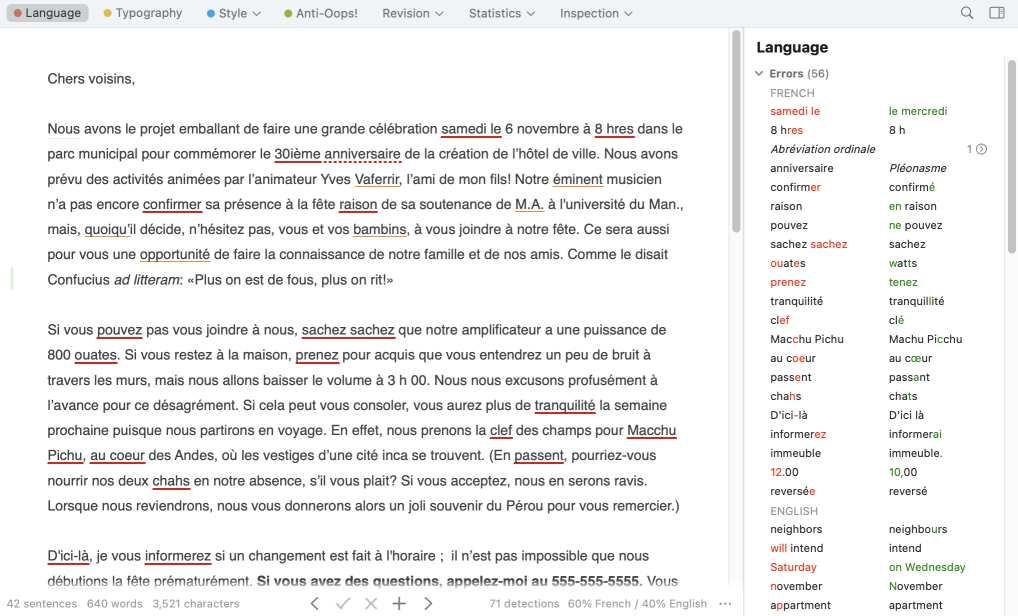
Antidote can detect and correct errors involving spelling, hyphens and capitalization; errors of grammatical agreement, including the notoriously difficult past participle; homophones (différent/différend, ces/ses, voir/voire, etc.) and other frequently confused words; the correct way to write dates, numbers or addresses in French; repetitions; inconsistent spelling; punctuation and spaces before punctuation marks; etc.
- Click Antidote’s Help menu and select Useful documents. In the folder that opens, you will find a folder titled Évaluation-fr. Open the rich text document inside titled Démonstration de correction to see the range of corrections that Antidote can make in French.
Two spelling standards have coexisted for French ever since far-reaching reforms were proposed by the Conseil supérieur de la langue française in 1990. The two conventions are called graphie traditionnelle and graphie rectifiée. Antidote can automatically correct your spelling to meet either of these two standards—the choice is yours. It can even flag inconsistent spellings of the same word in a text.
To help polish your prose, Antidote’s Style view highlights critical style questions for the French language through its five filters. They look for repetitions, long sentences, verbless sentences, various potentially awkward constructions, semantic redundancies, commonplace verbs, rare or long words, and many more. The Style view also highlights passages in which more equal representation of men and women is possible.
The Anti-Oops! view detects aspects of your writing that might be ill received by French-speaking readers, the same way it detects an abrasive tone in English. It keeps an eye out for sentences like Le manque de qualité de votre travail est inacceptable (“The lack of quality in your work is unacceptable”) or COMMENT OSES-TU ? (“HOW DARE YOU”) and flags them so you can adjust your wording to avoid any misunderstandings. It also detects sequences of words such as veuillez trouver le fichier ci-joint (“please find the attached file”) or je vous envoie une ébauche (“I am sending you a draft”) to remind you not to forget a supporting file or document.
In addition, the French corrector includes various linguistic filters that let you examine your text from several angles. The filters in the Revision view focus on certain pragmatic, logical and semantic aspects of the text. The Inspection view lays bare the sentence’s constituent elements: syntactic categories and functions, verb tenses, etc. The Statistics view compiles statistics on the text’s various linguistic parameters and illustrates them graphically: the various error types, the most frequent words, the distribution of words according to their etymology, etc.
Bilingual texts
A text written largely in French may also include passages in English and vice versa. These can consist of quotes, titles of books, etc. Antidote automatically identifies a text’s predominant language and flags passages in the other language with a vertical blue bar in the left margin. If the automatic language detection does not produce the expected result, you can manually specify the language of a particular passage or of the entire document by right-clicking the text in question and selecting Language of the Selection or Language of the Document. These options are also available from Antidote’s Corrector menu.
Statistical information on the distribution of the two languages is displayed in the status bar at the bottom of the correction panel (e.g. 58% French / 42% English).
Important: the number and type of errors flagged by Antidote’s French corrector depend on your settings, including those defined under First language and Written French ability. Various other settings are found in both the English and the French versions; see the Settings section in this chapter for more details.
The list of results

The list of results is divided by language: under each class of detection, the headings ENGLISH and FRENCH appear to clearly distinguish between the detections generated for each language.
Separate filters for each language
Certain filters feature two buttons, English and French, for multilingual texts. Clicking them lets you switch between the analyses of the French and English passages. The filters that display these buttons are (in the Statistics view) Error Types, Etymology and Categories; and (in the Inspection view) Categories, Phrases, Syntactic Functions and Conjugation.
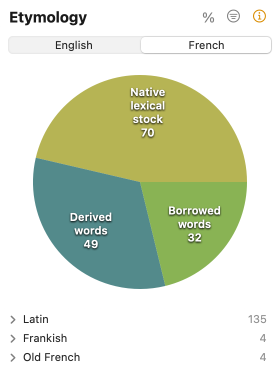
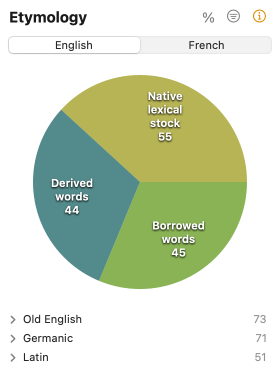
Using the corrector
In most respects, the French corrector is similar to the English corrector described in the Corrector chapter. Please refer to those pages for details on how the corrector operates similarly in both languages: the ways users can access the corrector, the meaning of the different types of underlining, descriptions of the different types of detections, the various settings, etc. This section describes features that are unique to Antidote’s handling of French texts.
Language-specific features of the Style view
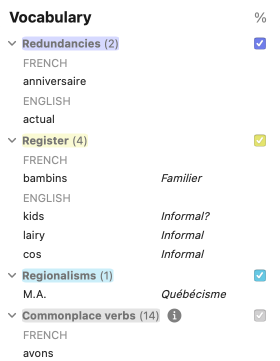
The options for the Style view apply to both languages, except when the language is specifically mentioned below the option.
The sections within the Style view adapt to the particularities of each language. For example, split infinitives are irrelevant to French, so the Constructions section of the French Style view does not detect them. However, it does include a number of detections specific to French, such as participial phrases and the formation of negatives. Similarly, in the Vocabulary section, the French Module distinguishes between offensive (e.g. racist, insulting, sexist) and inappropriate vocabulary (e.g. sexual, scatological, violent), while it does not detect contractions or nominalizations.
Most notably, the Gender neutrality filter produces different detections in French compared to its English counterpart, reflecting the different concerns specific to each language. The next points cover the gender neutrality treatment in French in greater detail.
Nouns, Pronouns and Agreement
To streamline the revision process, Antidote groups together gendered nouns (un client, une infirmière), nouns that are themselves gender neutral but that become gendered with the addition of an agreement marker (la responsable, les ministres élus, nous en sommes ravis), and gendered pronouns (il, quelques-unes). See the tooltip associated with each detection for suggested replacements; for example, the non-inclusive expression certains des linguistes can be replaced by the gender-neutral expression quelques linguistes.
Doublets
A doublet is made up of the feminine form and the masculine form of a word, such as le client ou la cliente, le ou la ministre, and ils ou elles. It’s a legitimate way of ensuring inclusivity by explicitly mentioning both genders. However, too many of them can weigh down the text and detract from the style. Where needed, this can be remedied by using the right mixture of inclusive language techniques.
Abbreviated doublets
Abbreviated doublets are sometimes used to represent both genders (e.g. client(e)) or both plural and singular (e.g. elle•s). However, they can complicate a text both visually and grammatically. What’s more, it is unclear how they should be pronounced. For these reasons, they are not recommended, regardless of the chosen format (parentheses, hyphens, etc.). You can choose whether you want Antidote to flag them. They can be replaced by standard doublets or other inclusive language techniques.
Reformulation With subscription
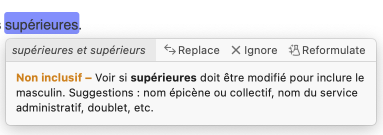

Antidote can generate reformulations for a variety of detections in the Style view. Notably for French, Antidote borrows reformulations from its Equalize view to provide you with gender-inclusive wording. Just click Reformulate in the tooltip.
- Antidote does not retain abbreviated doublets in its reformulations.
- Antidote does not reformulate full doublets (e.g. les clientes et les clients), which are gender inclusive. However, it does provide reformulations for abbreviated doublets (e.g. les client(e)s), which are inclusive but are not suitable in all written contexts.
Language-specific features of the Inspection and Statistics views
The National varieties filter that appears in the Inspection view for English does not exist in the French Module. However, the French Module does include three filters that don’t apply to English but are very relevant to French grammar: Agreement, which is far more complex in French; (grammatical) Genders; and Spelling rectifications. The Syntactic functions and Conjugation filters also differ with the French Module, owing to the differences between French and English grammars. You will also notice changes in the Etymology filter’s results (Statistics view), since far more words in French derive from Latin, Gaulish and Frankish origins.
Note — Learn more about the Inspection and Statistics views.
Detailed analysis

As in English, Antidote produces a detailed analysis of French sentences, with the difference that it employs certain notions that pertain to French grammar (e.g. épithète, genre, incise). For a clear definition of these terms, you can consult Antidote’s dictionaries.